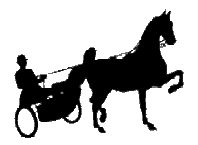|
Article:
|
One thing you should never do is buy a cart and hitch it up to your favorite riding horse expecting thehorse to know what to do. If it doesn't the results will certainly be exciting and most likely downright dangerous.
You do it in stages. It's work but enjoyable work. Most horses don't seem to mind pulling a load, in fact they seem to enjoy it. It's the noise and unfamiliar pressures on the harness from the moving cart that the horse must learn to accept.
However I'm jumping the gun a bit. Before worrying about training a horse to drive you need to learn to do it yourself.
Where to Start
- Look for a driving club or organization in your area or someone who teaches the sport.
The internet can be a help here in finding a club or trainer near you. - Get in touch with the American Driving Society.
You can contact them at -
http://www.americandrivingsociety.org/About_Carriage_Driving.htm - North of the border it's the Canadian Carriage Driving Society at -
http://www.norwestcontrols.com/cds/ - and in the UK a good contact is The British Driving Society at -
http://www.britishdrivingsociety.co.uk/ - Once you've become active in the sport you might want to participate in a carriage driving forum. A good one to subscribe to (it's free) is the Carriage Driving Forum at -
http://www.carriagedriving.net/cdl/cd-l.htmlm - And finally, there's a website which is a great place to start if you're thinking of getting started in carraige driving. It's based in the UK and is Discover Horse Carriage Driving
The Info Port for Recreational Horse Carriage Driving.
Learning to drive is similar to dressage. You work on patterns, large circles, small circles, figure eights, serpentine though pylons, etc., learning rein and cart management as you proceed. It will be somewhat tense at first but before long you'll be out on the road moving along at a walk or nice little trot.
Equipment
A good harness costs roughly the same as a good saddle. maybe a bit more. There's more leather parts to worry about than is the case with the saddle but once you understand what each part of the harness does, remembering what goes where is not difficult. I'd suggest looking for a good used harness to start with.
Skills
When sitting in a cart or buggy you don't have to worry about keeping centered and balanced, (i.e., maintaining a "good seat") as much as in the saddle. On the other hand you'll have to pay more attention to rein management as well as learning carriage management (so you don't sideswipe a tree or go off a cliff).
One of the more challenging aspects of learning to drive is getting the proper amount of pressure on the reins. At first the horse will move in a saw-tooth pattern, weaving back and forth but will "straighten out once you've got your act together.
I'd recommend learning driving first with someone else's horse(s) under the tutelage of an experienced carriage driver. Then if you want to train your own horse for driving, get the necessary equipment and go for it or have someone else train the horse. Ground driving, where you walk (or jog) behind the horse under harness, while controlling it through the reins is a good workout!
Advanced Driving
Once you've mastered driving a single horse you can take a shot at driving pairs. I guarantee it's more than twice as involved and difficult as driving singles but persistence will pay off. As I mentioned earlier, one of the necessities of driving pairs is in finding two horses that are compatible with one another - not always an easy thing to do.
Whether with one horse or more, if you like competition you can always work towards the show ring. And don't forget your local hometown parade. There's usually a spot for a horse and buggy there.
Books
I'm hesitant to suggest it as it may be out of print, but "On the Box Seat" by Tom Ryder is an excellent book on driving containing about everything you need to know on the subject.
Another book, from Canada, and definitely in print is "Breaking and Training the Driving Horse". This book will get you off to a good start, even if you don't intend to train your own horse - the basics are there for your information.
Copyright © 2005 W. Savage All Rights Reserved.
William "Bill" Savage, a retired, engineer lives on the Goose Bay Ranch in Montana where he spends time with family, horses, and his web site. You can read other articles of his on his web site https://www.your-guide-to-gifts-for-horse-lovers.com

